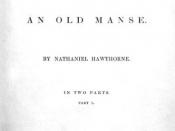In Nathaniel Hawthorne's "Young Goodman Brown," the story is told through the eyes of a limited omniscient third-person narrator. This style is very accommodating to the story because it allows the author perfect opportunities to express his points. The narrator can both describe what Goodman Brown is doing, and also evaluate and comment on the characters actions. This is a tool of the author to use the narrator to express his own personal beliefs on mankind. The narrator possesses the capability of reading the thoughts and feelings of the protagonist, the young Puritan husband, Goodman Brown, only among all the characters. As Brown turns the corner at the meeting house, he thinks:
" 'Poor little Faith!' thought he, for his heart smote him. 'What a wretch am I, to leave her on such an errand! She talks of dreams, too. Methought, as she spoke, there was trouble in her face, as if a dream had warned her what work is to be done tonight.
But, no, no! 'twould kill her to think it. Well; she's a blessed angel on earth; and after this one night, I'll cling to her skirts and follow her to Heaven.' "
This ability of the narrator is why the story has a limited point of view, since it does not apply to other characters in the story.
The narrator is an intrusive one who evaluates and comments on the actions and motives of the characters. When Goodman resolves to make this the last time that he ever does such a thing, the narrator evaluates his resolution:
" 'Well; she's a blessed angel on earth; and after this one night, I'll cling to her skirts and follow her to Heaven.'
With this excellent resolve for the future, Goodman Brown felt himself justified in...


